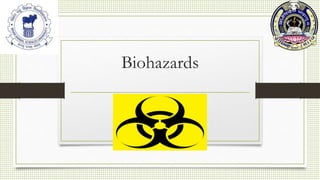Biohazards..pptx
•Download as PPTX, PDF•
0 likes•8 views
Risk categorization of Biological hazards, precautions and safety measures to be taken to handle different risk group biohazards
Report
Share
Report
Share

Recommended
Recommended
Biosafety on handling infectious micro- organisms
Biosafety on handling infectious animalsRecommended Biosafety level for Infectious Agents and Infected Animals

Recommended Biosafety level for Infectious Agents and Infected AnimalsChettinad Institute of Research and Education
More Related Content
Similar to Biohazards..pptx
Biosafety on handling infectious micro- organisms
Biosafety on handling infectious animalsRecommended Biosafety level for Infectious Agents and Infected Animals

Recommended Biosafety level for Infectious Agents and Infected AnimalsChettinad Institute of Research and Education
Similar to Biohazards..pptx (20)
Recommended Biosafety level for Infectious Agents and Infected Animals

Recommended Biosafety level for Infectious Agents and Infected Animals
Final-MoH_Ebola Laboratory Training_18_10_2022.pptx

Final-MoH_Ebola Laboratory Training_18_10_2022.pptx
Module 3 biosafety principles & microbiologycal risk group 21 1-18

Module 3 biosafety principles & microbiologycal risk group 21 1-18
Group 5 biohazard management and biorisk mitigation

Group 5 biohazard management and biorisk mitigation
Recently uploaded
Recently uploaded (20)
Site specific recombination and transposition.........pdf

Site specific recombination and transposition.........pdf
Human & Veterinary Respiratory Physilogy_DR.E.Muralinath_Associate Professor....

Human & Veterinary Respiratory Physilogy_DR.E.Muralinath_Associate Professor....
Module for Grade 9 for Asynchronous/Distance learning

Module for Grade 9 for Asynchronous/Distance learning
Efficient spin-up of Earth System Models usingsequence acceleration

Efficient spin-up of Earth System Models usingsequence acceleration
PATNA CALL GIRLS 8617370543 LOW PRICE ESCORT SERVICE

PATNA CALL GIRLS 8617370543 LOW PRICE ESCORT SERVICE
Porella : features, morphology, anatomy, reproduction etc.

Porella : features, morphology, anatomy, reproduction etc.
Understanding Partial Differential Equations: Types and Solution Methods

Understanding Partial Differential Equations: Types and Solution Methods
X-rays from a Central “Exhaust Vent” of the Galactic Center Chimney

X-rays from a Central “Exhaust Vent” of the Galactic Center Chimney
FAIRSpectra - Enabling the FAIRification of Spectroscopy and Spectrometry

FAIRSpectra - Enabling the FAIRification of Spectroscopy and Spectrometry
TransientOffsetin14CAftertheCarringtonEventRecordedbyPolarTreeRings

TransientOffsetin14CAftertheCarringtonEventRecordedbyPolarTreeRings
Thyroid Physiology_Dr.E. Muralinath_ Associate Professor

Thyroid Physiology_Dr.E. Muralinath_ Associate Professor
Call Girls Ahmedabad +917728919243 call me Independent Escort Service

Call Girls Ahmedabad +917728919243 call me Independent Escort Service
LUNULARIA -features, morphology, anatomy ,reproduction etc.

LUNULARIA -features, morphology, anatomy ,reproduction etc.
The Mariana Trench remarkable geological features on Earth.pptx

The Mariana Trench remarkable geological features on Earth.pptx
Genome Projects : Human, Rice,Wheat,E coli and Arabidopsis.

Genome Projects : Human, Rice,Wheat,E coli and Arabidopsis.
Biohazards..pptx
- 1. Biohazards
- 2. • Biohazard: Biological hazards refer to organisms or organic matters produced by organisms that are harmful to human health. • These include bacteria, virus, parasites, fungi and their toxins. • These may cause harm to human in the form of infections, allergy and poisoning. • Biosafety: The containment principles, technologies and practices that are implemented to prevent the unintentional exposure to pathogens and toxins, or their accidental release • Biosecurity: Control of accidental and deliberate release of biohazardous material
- 3. • Biohazard levels, more commonly referred to as “biological safety levels” or “biosafety levels,” are classifications of safety precautions necessary to be applied in the clinical microbiology laboratory depending on specific pathogens handled when performing laboratory procedures. • Laboratory facilities are designated as basic – • Biosafety Level 1, • Basic – Biosafety Level 2, • Containment – Biosafety Level 3, • Maximum containment – Biosafety Level 4.
- 4. • Biosafety level designations are based on a composite of the design features, construction, containment facilities, equipment, practices and operational procedures required for working with agents from the various risk groups. • Biohazardous Agents may be classified by Risk Group (RG) that are required biosafety precautions. • The risk group classification is used for laboratory work only.
- 5. Risk Group 1 (RG1)/Biohazard level 1 • Agents that are not associated with disease in healthy adult humans. • Example: Bacillus subtilis, canine hepatitis, Escherichia coli etc. • Handling these agents require minimum safety measures like gloves, masks etc.
- 6. Risk Group 2 (RG2)/Biohazard Level 2 • Agents that are associated with human disease which is rarely serious. • Preventative or therapeutic interventions are often available. • E.g., hepatitis A, B, and C, influenza A, Lyme disease, Salmonella, mumps, measles, scrapie, dengue fever. • Laboratory personnel can carry out diagnostic tests on the specimens but need to wear gloves, facial protection, and a gown. • Additionally, standard precautions at this level should be applied when handling clinical samples from the current outbreak investigations of acute respiratory distress syndrome (ARDS) caused by COVID-19..
- 7. Risk Group 3 (RG3)/ Biohazard Level 3 • Agents that are associated with serious or lethal human disease. • Preventive or therapeutic interventions may be available • High individual risk • Low community risk. • Example: West Nile virus, SARS virus, tuberculosis, typhus, Rift Valley fever, HIV, yellow fever, and malaria.
- 8. Risk Group 4 (RG 4)/ Biohazard Level 4 • Agents that are likely to cause serious or lethal human disease • Preventive or therapeutic interventions are not usually available • High individual risk • High community risk • Example: Bolivian and Argentine hemorrhagic fevers, Marburg virus, Ebola virus, hantaviruses, Lassa fever virus and Crimean-Congo hemorrhagic fever.
- 9. • There are no bacteria in this group. • Only specific persons can work with these viruses. • It requires them to wear a positive pressure personnel suit, with a segregated air supply. • There is no treatment available for these viruses, and extreme isolation precautions are mandatory.
- 11. The Biohazard Symbol with dimensions as defined in https://archive.org/stream/federalregister39kunit#page/n849/mode/1up